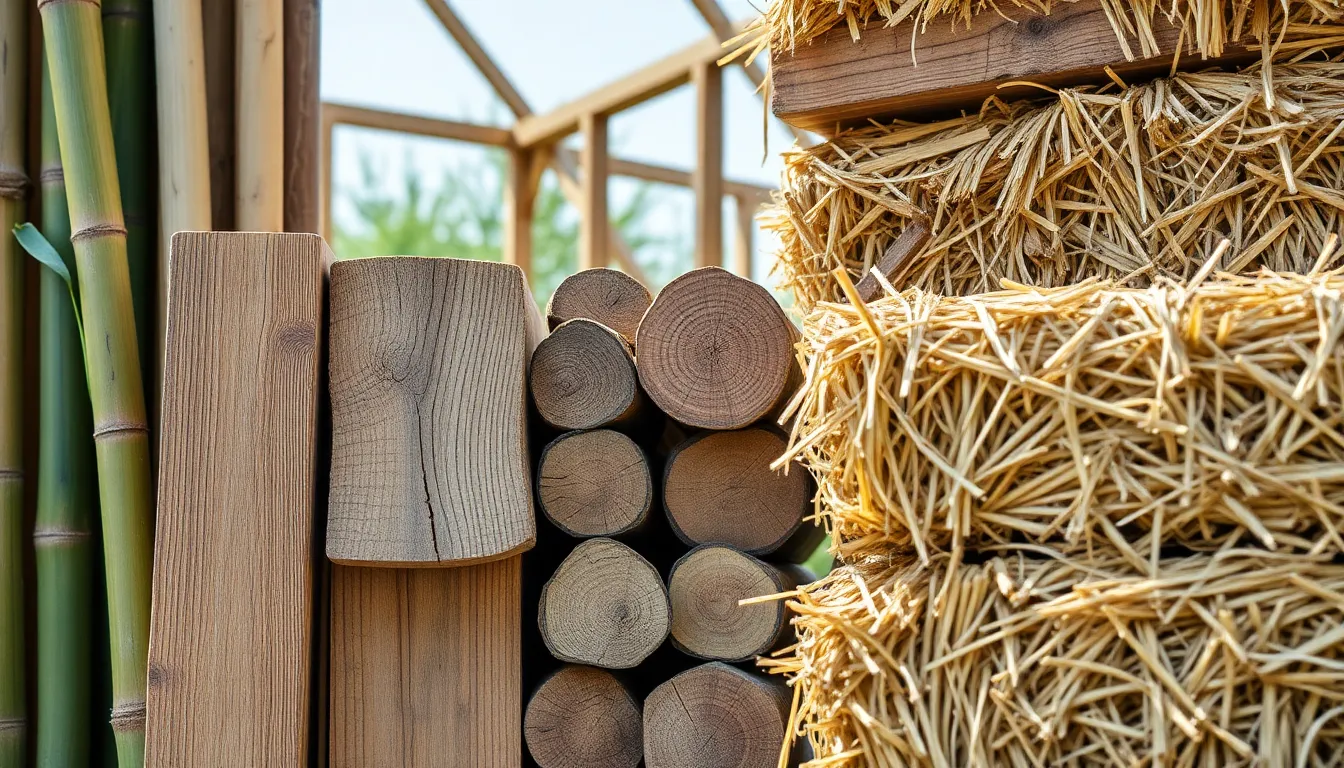Table of Contents
ToggleIn a world where Mother Nature occasionally throws a tantrum, the construction industry is stepping up its game with renewable building materials. Imagine a future where homes are not just structures but eco-friendly havens that give a high-five to the environment. From bamboo to recycled steel, these materials are not only sustainable but also stylish—who knew going green could look so good?
Overview of Renewable Building Materials
Renewable building materials contribute significantly to sustainable construction practices. These materials minimize environmental impact while enhancing aesthetic appeal and functionality.
Bamboo stands out due to its rapid growth and strength. As a versatile resource, it serves as an excellent alternative to traditional timber. In addition, recycled steel offers exceptional durability and a lower carbon footprint compared to new steel, making it a popular choice in modern construction.
Another noteworthy material is reclaimed wood. It not only reduces waste but also adds character to new structures. Uses of reclaimed wood include flooring, furniture, and structural beams. Zero-waste concepts encourage builders to incorporate materials that promote recycling and resource efficiency.
Additionally, straw bales provide insulation and are often utilized in wall construction. Their affordability and effectiveness support a growing interest in eco-friendly homes. Natural fiber composites, created from materials like hemp and flax, also gain traction. These composites are lightweight and strong, allowing for innovative design solutions.
Moreover, insulating concrete forms utilize recycled materials and provide energy efficiency in residential buildings. Structures developed from these forms typically experience reduced energy costs.
Natural stone, sourced sustainably, enhances the aesthetic quality of buildings. Its use can embody both luxury and environmental responsibility.
Each renewable material plays a crucial role in minimizing waste and conserving resources. By choosing renewable options, builders can support the construction industry’s sustainable future.
Types of Renewable Building Materials

Several renewable building materials are gaining traction in the construction industry, each known for its unique benefits and sustainability contributions.
Bamboo
Bamboo stands out due to its rapid growth rate, reaching maturity in just three to five years. Its strength and flexibility offer a viable alternative to traditional timber, making it popular among eco-conscious builders. Known for its high tensile strength, bamboo can withstand heavy loads, often competing with steel. In addition to its structural benefits, bamboo possesses natural resistance to pests, reducing the need for chemical treatments. Builders frequently use bamboo for flooring, scaffolding, and even furniture, enhancing both form and function in eco-friendly designs.
Recycled Wood
Recycled wood provides an excellent way to minimize waste while preserving the aesthetic appeal of a structure. By repurposing old wood from deconstructed buildings, manufacturers save valuable resources and reduce landfill contributions. This material often carries a distinctive character, including unique grain patterns and colors, making each piece truly one-of-a-kind. Recycled wood also reduces the carbon footprint associated with new lumber production, promoting sustainable forestry practices. It finds application in flooring, cabinetry, and architectural accents, contributing warmth and charm to various projects.
Straw Bales
Straw bales serve as an innovative insulation material, offering significant energy efficiency at a low cost. Commonly sourced from agricultural by-products, they provide an effective means of reusing leftover straw while delivering excellent thermal performance. Structures built with straw bales often maintain stable indoor temperatures, reducing heating and cooling energy needs. Builders appreciate the affordability of straw bale construction, making it accessible for various budgets. Additionally, straw bales are biodegradable, ensuring environmentally responsible disposal once a building reaches the end of its life cycle.
Benefits of Using Renewable Building Materials
Using renewable building materials offers significant benefits that enhance both sustainability and economic viability. Their incorporation into construction transforms the industry toward a greener future.
Environmental Impact
Renewable building materials actively reduce environmental deterioration. Bamboo grows quickly, minimizing deforestation pressures associated with traditional lumber. Recycled steel lowers energy usage during production, curbing greenhouse gas emissions. Additionally, reclaimed wood repurposes waste, diverting it from landfills while preserving natural resources. Straw bales utilize agricultural by-products, contributing to waste reduction. Natural fiber composites provide a sustainable alternative by sourcing renewable plants like hemp and flax. Each material serves to decrease carbon footprints, promote biodiversity, and protect ecosystems in the construction process.
Economic Advantages
Choosing renewable building materials can lead to substantial economic savings. Lower energy consumption in production translates into reduced costs for builders and consumers. Reclaimed wood creates distinctive aesthetics while encouraging a circular economy that fosters job creation in recycling sectors. Bamboo’s rapid growth provides a steady supply chain, decreasing dependency on slower-growing species. Straw bales offer affordable insulation solutions with long-term energy savings. Furthermore, the durability of materials like recycled steel minimizes maintenance expenses over time. Long-term investments in renewable options ensure both ecological benefits and favorable returns, enhancing overall project profitability.
Challenges and Considerations
Renewable building materials offer significant advantages, yet they present challenges in availability, sourcing, performance, and durability.
Availability and Sourcing
Sourcing renewable materials often involves logistical complexities. Geographic location influences access; certain regions may lack local suppliers of bamboo or recycled steel. Establishing a reliable supply chain can minimize disruptions, yet high demand sometimes outpaces availability. Building materials like reclaimed wood require deconstruction of older structures, which may not occur frequently enough to meet market needs. Furthermore, regional regulations may impact sourcing; builders must navigate compliance to verify sustainability claims. Consequently, prioritizing local resources can enhance supply chain stability while reducing carbon footprints.
Performance and Durability
Performance varies among renewable materials, necessitating thoughtful selection based on project requirements. Some materials, for instance, may not withstand severe weather conditions as effectively as traditional options. Bamboo exhibits impressive strength but can suffer from moisture vulnerability if not treated properly. Recycled steel showcases durability but may require protective coatings for longevity. Additionally, straw bales excel in insulation properties but need proper construction techniques to prevent moisture infiltration. Evaluating these factors ensures that renewable materials meet performance standards while enhancing longevity and functionality in building projects.
The shift towards renewable building materials represents a pivotal moment in the construction industry. By embracing options like bamboo, recycled steel, and reclaimed wood, builders can create structures that are not only sustainable but also visually appealing. These materials contribute significantly to reducing environmental impact while offering economic benefits.
As the demand for eco-friendly construction continues to grow, it’s essential for industry professionals to navigate the challenges associated with sourcing and performance. Prioritizing local resources and understanding material properties can lead to successful projects that align with sustainability goals. The future of construction lies in innovative solutions that balance aesthetics, functionality, and environmental responsibility.




